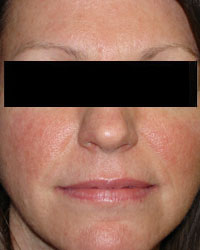Rosacea affects the eyes in many patients, and may result in a watery or bloodshot appearance, irritation and burning or stinging. The eyelids may also become swollen, and styes are common.
April has been designated as Rosacea Awareness Month with the intent to educate the public on the warning signs of this chronic but treatable facial disorder. Rosacea is a common but poorly understood disorder of the facial skin that is estimated to affect well over 16 million Americans — and most of them don’t know it. In fact, while rosacea is becoming increasingly widespread as the populous baby boom generation enters the most susceptible ages, a National Rosacea Society survey found that 95 percent of rosacea patients had known little or nothing about its signs and symptoms prior to their diagnosis.

Rosacea typically presents anytime after the age of 30 and may initially resemble a simple sunburn or an inexplicable blush. Suddenly, without warning, a flush comes to the cheeks, nose, chin or forehead. This recurs over and over with the redness lasting longer each time and eventually visible blood vessels may appear. Without treatment, bumps and pimples often develop, growing more extensive over time and burning and itching are common.
In severe cases, especially in men, the nose may become enlarged from the development of excess tissue. This is the condition that gave comedian W.C. Fields his trademark red, bulbous nose. The eyes can be affected too. Ocular involvement includes watery, burning and bloodshot eyes.
Ongoing research has suggested that rosacea may be caused by various possible factors, including defects of the immune system, nervous system, facial blood vessels and genetics. Most recently the presence of microbes and Demodex mites on the skin can trigger symptoms. Demodex are normal inhabitants of human skin but occur in far greater numbers in people with rosacea. It is believed that an immune response to bacteria associated with the mites may lead to the inflammatory bumps and pimples.
A study by a dermatologist at Duke University found a significant association between the relative presence of the mites and the development of rosacea, suggestion that the microscopic mites may be involved in the disease process. The study authors also proposed that increased mite density in the skin might trigger inflammatory response, block hair follicles or help transmit other bacteria in the skin , leading to signs and symptoms of rosacea.
Demodex mites also live in the eyelash follicles. they survive on dead skin and protein. We have found that reducing the number of Demodex living on the eyelid can reduce dry eye symptoms of burning and waterness. Controlling the Demodex requires a special cleaning solution containing a derivative of Tee Tree Oil. If you have or suspect you have rosacea and are suffering from burning red eyes, make an appointment in our dry eye clinic for evaluation and treatment.
Although the definitive cause of rosacea remains unknown, a vast array of lifestyle and environmental factors have been found to trigger flare-ups of signs and symptoms in various individuals. Common rosacea triggers include sun exposure, emotional stress, hot or cold weather, wind, heavy exercise, alcohol, spicy foods, heated beverages, humidity, certain skin-care products and potentially an overabundance of Demodex mites.
Signs and Symptoms of Rosacea
- Redness on the cheeks, nose , chin or forehead
- Small visible blood vessels on the face
- Bumps or pimples on the face
- Watery or irritated eyes